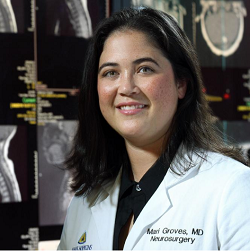
Pediatric NeuroNews
When pediatric neurosurgeon Mari Groves was receiving her fellowship training here four years ago, a friend’s child began developing progressive weakness and other puzzling symptoms. Imaging showed that this toddler had an extensive thoracic tumor. Although some might have found such a tumor unresectable, remembers Groves, this patient underwent surgery at Johns Hopkins—a procedure so transformative that he’s required little intervention since.
The case reaffirmed the reasons why she chose this specialty, she says. “With many adult conditions, there’s little you can do to change the overall prognosis of the disease,” she explains. “But with pediatrics, we often have the chance to change the course of a child’s life.”
After coming to Johns Hopkins for her residency in 2007, she spent the next eight years here receiving training through her pediatric neurosurgery fellowship, under the direction of former director of pediatric neurosurgery George Jallo. She received additional training in spine deformities at Shriners Hospitals for Children in Philadelphia, then joined the faculty of Johns Hopkins in January 2016.
Share Fast Facts
Treating a Spectrum of Neurosurgical Conditions: From Infancy to Adulthood Click to Tweet
Groves cares for patients from infancy to adulthood. Several of the conditions she treats, such as myelomeningoceles and tethered cords, are typically diagnosed and treated very early in a child’s life. Although some aspects of these conditions can linger into adulthood, Groves explains, many adult neurosurgeons are uncomfortable working with patients who have graduated from pediatric practice. “I want to bridge that divide and take care of these patients in adulthood as well,” she says.
Groves treats a variety of conditions, including brain tumors, Chiari malformations, spinal cord tumors and spinal deformities—pathologies that are often extraordinarily challenging and complex. “Some of these patients have been told that nothing can be done,” she says, “so they’re particularly grateful when we’re able to provide treatment.”
Many of her cases require a team approach that involves a cadre of specialists in other disciplines. For example, Groves is part of the Johns Hopkins Greenberg Center for Skeletal Dysplasias, which aims to comprehensively treat this group of conditions with the help of experts in orthopaedic surgery, otolaryngology–head and neck surgery, pulmonology and other specialties.
For her pediatric tumor cases, Groves and colleagues from pediatric medical and radiation oncology work together to develop an individual treatment plan for each patient to optimize outcomes.
No matter what condition her patients have, her primary goal is to help patients and their families get back a sense of normalcy.
“Parents have faith and trust when they give the most important things in their lives to us,” Groves says. “I want them to know that I understand where they are, and we’ll do everything we can to help their children live full lives.”


